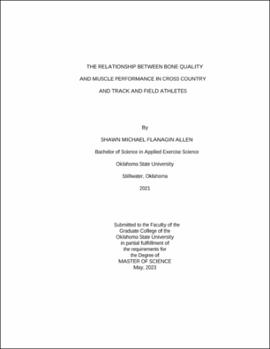| dc.contributor.advisor | Baker, Breanne | |
| dc.contributor.author | Allen, Shawn Michael Flanagin | |
| dc.date.accessioned | 2023-08-25T20:05:49Z | |
| dc.date.available | 2023-08-25T20:05:49Z | |
| dc.date.issued | 2023-05 | |
| dc.identifier.uri | https://hdl.handle.net/11244/338895 | |
| dc.description.abstract | Introduction: Cross-Country and Track and field (XC+T&F) athletes exhibit high levels of lower body bone injuries compared to other collegiate athletes, as well as lower levels of areal bone mineral density (aBMD). Lower aBMD has been associated with increased frequency and severity of bone injuries. The best none pharmaceutical way of increasing aBMD and reducing these injury risks are through physical training. Both strength and power movements have both been shown to elicit these increased bone mineral density adaptations, but which one of these are a better stimulus? Our study looks to fill this gap of knowledge by looking evaluating both power and strength muscle output and characterizes and their ability to predict total body and site-specific bone mineral density values. Methods: Thirty-three XC+T&F athletes provided informed consent followed by an injury and activity questionnaire. Dual-energy X-ray absorptiometry was used to access body composition and aBMD, prior to this, athletes conducted a urine analysis for hydration status and height and weight measurements. Unilateral dynamic knee extension and flexion of both legs were measures by a Biodex 3. Athletes completed three repetitions at 60, 120 and 180°/sec; these speeds are clinically associated with strength, mixed, and power, respectively. Independent t-tests were used to assess initial differences between XC+T&F sex baseline characteristics. Pearson’s correlation coefficients were calculated to inform independent variables suitability for regression modeling. Forced linear regression modeling evaluated if strength only or power only models accounted for the greatest amount of variance in total body and 4 site-specific aBMD area, as well as three hip structural analysis measures. Results: Both strength and power regression models were able to account for variance within ranges of 21.0-59.4% ± 9.6% (all p≤0.005), but power was able to not only predict the greatest number of variables with significance, but it also had the greatest magnitude of variance that could be accounted for. Power models provided an additional 9.2-25% ± 7.9% increase for accounting for variance over strength models. Conclusion: Power training may be a better modality for training over strength, for both athletes and clinical populations that are pursuing greater aBMD adaptations. | |
| dc.format | application/pdf | |
| dc.language | en_US | |
| dc.rights | Copyright is held by the author who has granted the Oklahoma State University Library the non-exclusive right to share this material in its institutional repository. Contact Digital Library Services at lib-dls@okstate.edu or 405-744-9161 for the permission policy on the use, reproduction or distribution of this material. | |
| dc.title | Relationship between bone quality and muscle performance in cross country and track and field athletes | |
| dc.contributor.committeeMember | Smith, Doug | |
| dc.contributor.committeeMember | Dinyer-McNeely, Taylor | |
| osu.filename | Allen_okstate_0664M_18189.pdf | |
| osu.accesstype | Open Access | |
| dc.type.genre | Thesis | |
| dc.type.material | Text | |
| dc.subject.keywords | bone mineral density | |
| dc.subject.keywords | injury protection | |
| dc.subject.keywords | power | |
| dc.subject.keywords | strength | |
| thesis.degree.discipline | Health and Human Performance | |
| thesis.degree.grantor | Oklahoma State University | |
